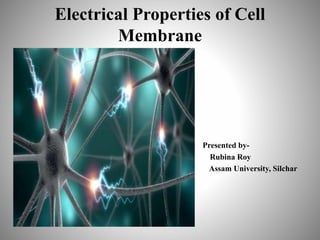
Presentation on Electrical Properties of Cell Membrane
- 1. Electrical Properties of Cell Membrane Presented by- Rubina Roy Assam University, Silchar
- 2. CONTENTS • Introduction • Membrane Potential -Ion Channels -Ion Pumps - Sodium Potassium Pump • Determination of Membrane Potential • Action Potential -All-Or-None Law • Role of Cell Electrical Properties in Animal Body - Transmission of Nerve Impulses - Muscle Contraction & Relaxation • Conclusion • References
- 3. INTRODUCTION • Cells are bounded by membranes which are composed of phospholipid bilayers. • The phospholipid bilayer acts as a conductor to non polar molecules like oxygen, carbon dioxide, nitrogen, benzene, and uncharged polar molecules like water, urea, glycerol. • Charged polar ions like H+, Na+, K+, Cl-, HCO3 -, etc., and uncharged large molecules like glucose, amino acids, nucleotides get trapped by the hydrophobic fatty acid chains acting as an insulator. • The positively charged ions are carried across the membrane by transport proteins. • Membranes are highly impermeable to anions.
- 4. Membrane Potential The membrane potential is the difference in electrical charges between the extracellular matrix and the cytoplasm of a cell. It is maintained by ion channels and ion pumps. At this resting state, the cytoplasm of cell has higher negative charge than the extracellular matrix, and the membrane is sad to be polarized maintaining a dipole across the membrane. In non-excitable cells, the membrane potential ranges from -20 mV to -200 mV. In case of excitable cells (neurons and muscle cells), the membrane potential is about -70 mV, and is called resting potential.
- 5. Ion Channels • Ion channels are transport proteins which carry ions along the concentration gradient across the cell membrane. • Ion channels are of two types- voltage gated channels and ligand gated channels. • Voltage gated channels open only in response to change in electric potential. • There are 4 types of voltage gated channels- Na+ channels, Ca2 + channel, K+ channel, Cl- channel. • Ligand gated channels open in response to a binding ligand.
- 6. Ion Pumps • Ion pumps carry ions against the concentration gradient at the expense of energy. • It is mediated by the carrier protein ATPase which carries the ions across the membrane by hydrolysing ATP. • There are 3 types of ATPases- P-ATPase, F-ATPase, V-ATPase. • P-ATPase includes NA+ K+ ATPase, CA2 + ATPase, which carry Na+, K+ and Ca2 + ions, • F-ATPase & V-ATPase carry H+ ions across the membrane.
- 7. Sodium Potassium Pump Also called Na+ K+ ATPase, is a transport protein which transports Na+ and K+ ions across the membrane by hydrolysing ATP. It has high affinity for Na+ than K+. It is a heterodimer composed of 2 subunits- alpha subunit and beta subunit.
- 8. Determination of Membrane Potential • At thermodynamic equilibrium, the membrane potential is equal to the potassium equilibrium potential. The magnitude of potassium potential is given by Nernst equation, EK = where, R= Gas constant= 1.987 cal/(degree mol) T= Absolute temperature= 293 k at 20°c Z= charge= 1 F= Faraday constant = 96,000 coulombs/(mol V) [K+]o = concentration of K+ ions in the extracellular fluid [K+]i = concentration of K+ ions in the intracellular fluid
- 9. Action Potential • Action potentials are initiated by stimulus & generated by Na+ & K+ voltage gated channels found. • Depolarization is immediately followed by repolarization, which is mediated by the voltage gated K+ channels and voltage gated Cl- channels. • Single stimulus with greater strength cannot carry the action potential along the cells. Signal transmission requires a series of successive stimuli which can depolarize the membrane upto threshold potential to initiate an action potential. This is called the All-or-none law. • The gap period between repolarization and depolarization by successive stimuli is called refractory period.
- 10. Transmission of Nerve Impulses
- 11. Action Potential in Muscle Contraction
- 12. Conclusion • Membrane’s electrical properties are of utmost importance for the continuous communication among different cells and tissues, normal functioning of all the physiological processes, and maintaining body homeostasis and shape. • Any mutation in the genes encoding the transport proteins carrying the ions across the membrane, may lead to the disbalance in the electric potential between extracellular fluid & cytosol, resulting in diseases like Cystic Fibrosis, Snowflake Vitreoretinal Degeneration, Barter Syndrome, Alzheimer’s Disease, etc. • These genetic hereditary diseases ca be treated by correction or replacement of the mutated gene.
- 13. References Niebur, E. (2008). Electrical properties of cell membranes. Scholarpedia, 3(6), 7166. Zaydman, M. A., Silva, J. R., & Cui, J. (2012). Ion channel associated diseases: overview of molecular mechanisms. Chemical reviews, 112(12), 6319-6333. Hübner, C. A., & Jentsch, T. J. (2002). Ion channel diseases. Human molecular genetics, 11(20), 2435-2445.
- 14. THANK YOU